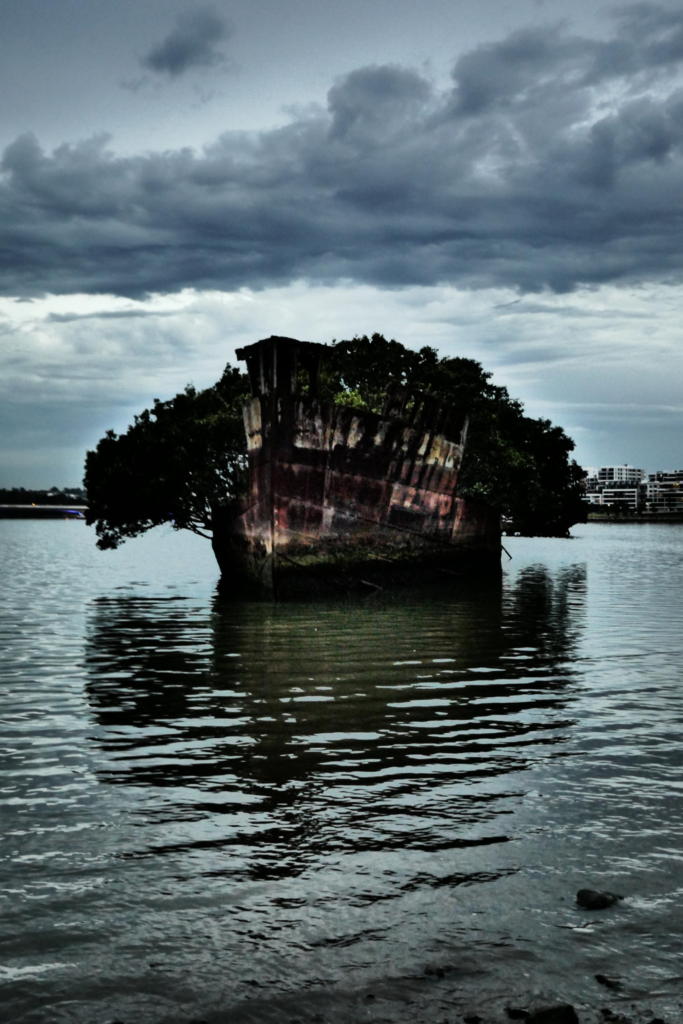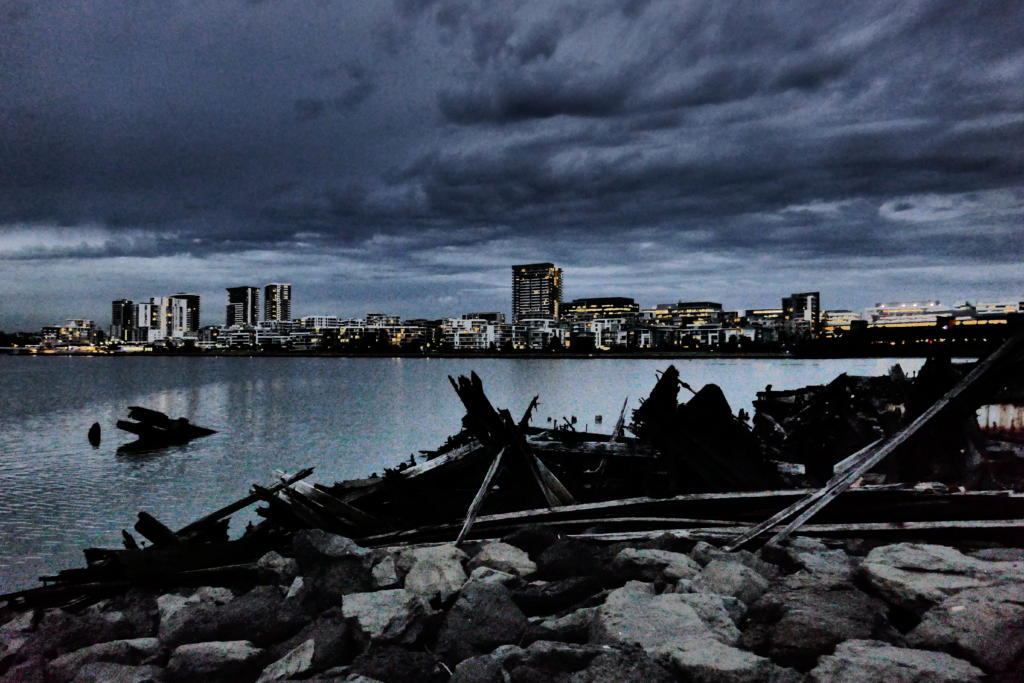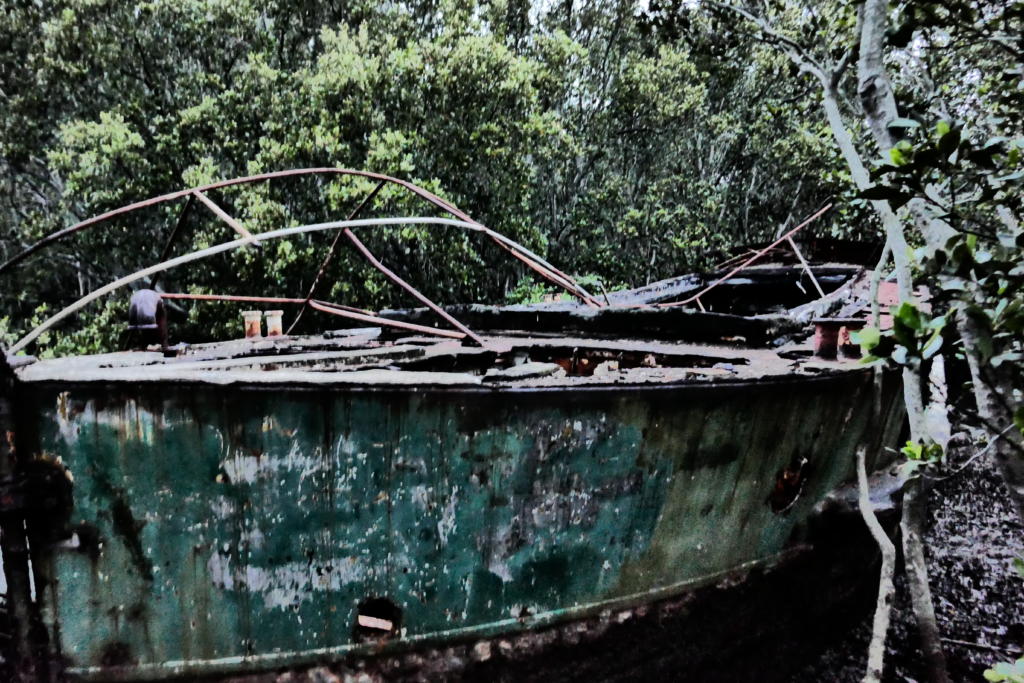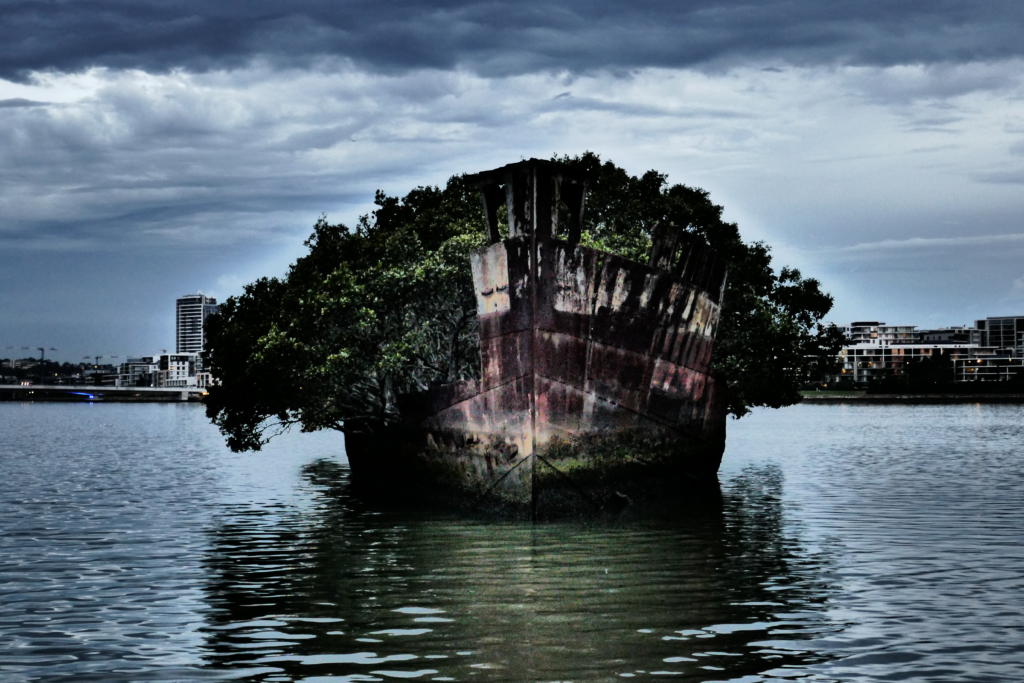Alone with the SS Ayrfield Shipwreck, the Floating Forest of Sydney
It took a moment for my eyes to adjust to the bright screen but the image in front of me took me by surprise. The SS Ayrfield stood proud of the water against the backdrop of a cloudless sunrise, her rusty hull glowing in the sunlight that gleamed off the water. What fascinated me the most, however, was the lush foliage growing out of the shipwreck that she sported like a tiara.
While I had set my desktop wallpaper to change periodically, I didn’t expect any of the images that greeted me whenever I opened my laptop to be that captivating. I had to find out where this remarkable sight was photographed. As it turned out, it was not in a remote place but in Homebush Bay, a Sydney suburb.
It’s true: I hadn’t been to that part of Australia in 25 years, and a desktop wallpaper was one of the reasons I returned.
As you can see, I sought out the shipwreck in very different weather. It wasn’t my goal to replicate that image, though, and I’m still chuffed by what I saw on the journey and the photos I took. I haven’t been able to Google it either, so my description will suffice.

Nasir al-Mulk Mosque: Another place that I visited because of a photo
History of the SS Ayrfield floating forest
According to the large plaque in the ground at Shipwreck Point (a five-minute walk away), there used to be a ship wrecking yard in the area, right next to a salt marsh and the Badu mangrove. More inscriptions on a telescope stated that the SS Ayrfield and the nearby SS Mortlake Bank were colliers. Both vessels were scuttled in the bay in 1972.
Throughout that time, the wrecks were left untouched, even as the area was redeveloped. The seeds of mangrove plants sprouted in the Ayrfield‘s hull, presumably after birds scattered them or they drifted there, and they claimed what was once Man’s for Nature. It acquired the nickname ‘Floating Forest’ among the locals.
After a clean-up, the area now known as Wentworth Point became accessible to the public in 2003. However, prominent signs warn people that the waters are still too contaminated for fishing.
The long way through Badu mangrove
It was just my luck that I chose to check out the shipwrecks on the only overcast day of my five days in Sydney. I also decided to take the longer route via public transport, saving the Ayrfield for last. That meant a walk along the asphalt path that ran through the Badu mangrove. It was largely monotonous, although I got glimpses of the setting sun through gaps in the trees. No deadly Australian creatures to worry about here, thankfully – all I encountered were a magpie-lark and one Australian cyclist. Perhaps I should have cycled too.
The first sign that I was getting close was the sight of the HMAS Karangi, or what was left of this former navy ship. I couldn’t get a clear look at her through the trees but it was overgrown too. To get a better view, one has to get off the path or be on the other side of the creek.
Five minutes later, a man-made peninsula marked Shipwreck Point. The wreck of the tugboat SS Heroic surprised me, not just because she was relatively well-covered by the vegetation until I was right next to her, but also because she was much closer than expected. I could almost jump onto it but I didn’t want to risk contracting tetanus, so I played around with my camera’s settings. I found one that brought out the gloomy clouds and accentuated the hues of the rust and stuck with it.


Through a telescope, I spotted the SS Mortlake Bank and the rear of the SS Ayrfield on the other side of the creek, so I returned to the path and headed there.
Up close and alone with the SS Ayrfield
In some of the photographs on the web, you can see the buildings of Rhodes behind the shipwreck. They don’t show that you practically stand in someone’s backyard to admire it. A narrow pebble-strewn path led to the back of Homebush Bay Apartments and that’s all the space that everyone gets to take photos from. At least I was completely alone throughout my time there – perhaps the grey skies had something to do with it.
Looking around me, the lack of sunshine wasn’t such a big loss. The buildings all around Homebush Bay ensured that the floating forest would be covered in shadow on a clear day anyway.
The SS Ayrfield lay mere metres from me, unmoved by the dark clouds above. Her crown of foliage had no need for the nourishment of rainwater, after all. Now that I had come so far, I was happy to sit on the edge of the path and watch the birds return to roost as the buildings in the distance lit up. *Insert contemplation of how the wreckage will crumble one day, leaving a rust stain on the riverbed and a ship-shaped island.*
It would be hubris to say that there was a connection, let alone a telepathic conversation. Those few moments when I had her and the view to myself were special, though.

Follow the link for more ideas on other places to see and tips on planning a trip to Australia at Travel With Me 24X7.
Getting to the SS Ayrfield floating forest
From Central Station, take the T1 train line towards Epping via Strathfield. Alight at Rhodes Station. From Stand C, take Bus No. 533 towards Sydney Olympic Park. Alight six stops later, opposite the Archery Centre. The shipwreck is behind Homebush Bay Apartments.
You can also alight the train at Concord West just as I did. From the platform, get to King Street and head north. Turn left onto Victoria Avenue, walk all the way to the end and enter the park. Cross Powell’s Creek, turn right and follow the path through the Sydney Olympic Park and the Badu mangrove. You’ll see the other shipwrecks in Homebush Bay along the way, like HMAS Karangi. However, it involves crossing Bennelong Parkway twice to get from Shipwreck Lookout Point to the SS Ayrfield without the aid of regulated crossings. Be careful, especially when it gets dark.
Got a car? Find parking along Bennelong Parkway and walk over.